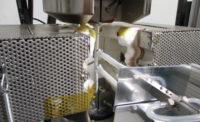NDT | Fatigue Testing
The Future of Fatigue Testing
Newer techniques are on the rise. As manufacturing evolves, so too does fatigue testing.

All Images Source: Getty images
Fatigue testing gives researchers and product designers the ability to create materials and components that will last for their intended life cycle. This makes the technique critical to quality efforts, experts say.
The product design and manufacturing fields have grown exponentially over the past couple of decades, says Abi Iyer, test engineer, TUV Rheinland of North America. Because of this, products are becoming increasingly complex.
“The parts that go into these products are required to be of very high quality and need to be able to have a longer service life,” Iyer says. “Most companies today focus on building quality products that can perform exceedingly well in order to reduce expenses in the form of services and repairs after the product has hit the market.”
Fatigue testing is unique in that it repeatedly exposes parts to “real-world” conditions, producing data and results that helps manufacturers predict the part’s durability.
“Rather than waiting for a number of years for the part or product to undergo so many cycles and then understand its mode of failure, fatigue testing helps us understand this beforehand and this helps companies perform design improvements,” Iyer says. “Moreover, this will also allow for the product manufacturers to define maintenance routines and practices to maintain their operating life without any catastrophic failures. It gives them a chance to inspect and replace parts that may be on the verge of failing due to accumulated damages that aren’t visible through intermittent cursory visual inspections.”

While static mechanical testing takes a snapshot of a material or a component’s mechanical characteristics, fatigue testing looks at the full life cycle, says Jarid Barthold-Robinson, senior product specialist, Shimadzu Scientific Instruments.
“Fatigue testing exploits flaws such as microcracks or inclusions in the product that leads to failure after repeated use,” he explains.
A specimen can undergo various fatigue cycles, Iyer says, including low-or-high cycle fatigue, low cycle fatigue under the influence of temperature, or even corrosion fatigue.
“Each type of fatigue cycle depends on the application the part, for which the specimen is being tested, will be used for in service,” Iyer explains.
Fatigue generally occurs when the stresses in a region lead to plastic deformation and micro cracks. Eventually, the cracks coalesce and form a major crack over the loading cycles. The initial cracking could also result from an overloaded loading event.
“These cracks then grow to cause the failure of the part in service,” Iyer says.
Knowing exactly how many cycles it will take for the part to fail will give the design team critical data, such as on how the part can fail when put into service. This will aid them to make any design changes so that a part can withstand the stresses designed for its life expectancy.
Fatigue testing has its challenges, however. For example, tests lasting for days at a time, so throughput is low. Manufacturers can remedy this with higher frequency testing, as well as economically integrating multiple instruments with single control and power systems, says Barthold-Robinson.
Operators must also know what types of loading will be required ahead of time, which isn’t easy, Iyer says.

“Loading is not uniaxial alone. With parts undergoing deformation and wear over time, it is difficult to know all the forms of stresses that it will undergo when installed,” Iyer explains. “If parts are reengineered for the same application, then there is historical data to re-validate a part” — but with new designs and new parts, knowing the requirements is paramount.
Another major challenge is the need for a fatigue testing machine that can perform the test on a specimen, Iyer says. “With parts being made to withstand loading in different directions, the machine itself should be able to apply multiaxial and multi-conditional loading while being able to withstand the fatigue loads that it is applying. It should be able to last so many more cyclic tests without having to be shut down for maintenance. The demand for fatigue testing equipment will only keep increasing as advancement into the design and manufacturing of this equipment with customizable options is continuously supported.”
To choose the right fatigue testing solution, details are key, says Barthold-Robinson.
“Fatigue solutions are dependent on the material or component being tested,” he says. “Force, frequency, displacement, and fixturing are the main considerations. Actuation methods are also a consideration, choosing between hydraulic, electromagnetic, or other techniques.”
As manufacturing evolves, so too does fatigue testing.
For example, new technologies such as ultrasonic fatigue testing using sample resonance are gaining attention in both academia and industry, Barthold-Robinson says. “This technique allows testing to ultra-high cycle counts in short periods of time,” he says.
The types of materials being tested are changing as well. “As new materials such as CFRP and additive manufactured alloys make their way into more products, their fatigue life needs to be more carefully understood,” Barthold-Robinson explains.
With continued improvements being made to software that helps to design materials and parts, it is becoming easier to design parts and perform theoretical calculations of the life expectancy of the part once it is put into service, Iyer says.

“But in order to validate the calculations, these parts must undergo fatigue tests in order to subject them to physical forces and conditions,” he adds. “Newer materials and material combinations are being researched upon and prototypes are being made with these materials to see if they provide any advantages in the form of strength and weight.”
This could lead to energy savings, Iyer says, which is a key factor in so many critical industries such as the medical, automobile, space and aeronautical, and oil and gas industries.
“In today’s world, conventional manufacturing techniques are being rivaled by additive manufacturing techniques that are still in their infant stages — but still show a lot of promise,” Iyer says. Newer techniques help to reduce the number of defects within a part while also increasing control over the manufacturing of that part.
“While companies have historical data on conventionally made parts that undergo fatigue failure, these newer manufacturing techniques are still being put to the test to see how it will improve the life of the part or product,” Iyer says. “As more challenges with additive manufacturing are solved, the fatigue life of the samples may improve considerably.”
Looking for a reprint of this article?
From high-res PDFs to custom plaques, order your copy today!






